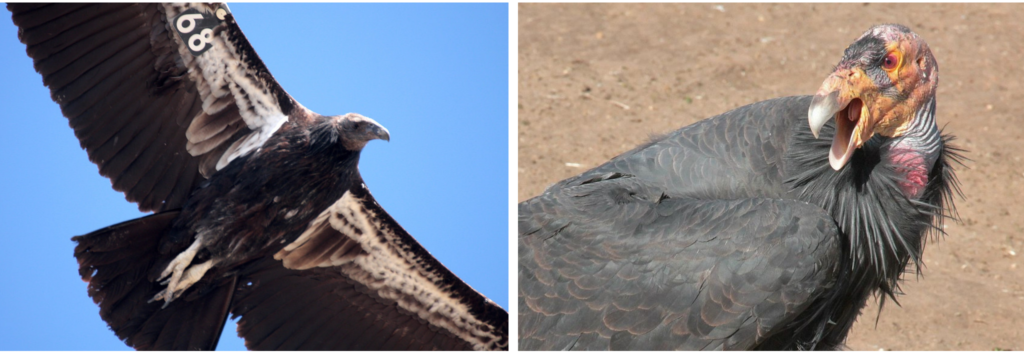Aversive Conditioning in Conservation
Field observations, similar to those examples mentioned in my last blog, show that aversive conditioning is pervasive throughout the natural world. Birds and mammals, having large and complex brains, are especially responsive to this type of learning. Let’s review one practical application for conservation.
The American condor, a native of our western mountains and coast, gradually drifted toward extinction over the past century. A popular theory was that because they were part of the megafauna that died off 12,000-15,000 years ago, they were no longer well-adapted to today’s world, so their sad fate was somehow inevitable. But you only had to sit on a California mountaintop with your binoculars or spotting scope, in a wind that would blow your hat off, and watch a condor hover nearly motionless and effortlessly over the adjacent valley to realize that this was nonsense. When I encountered a little group of them feeding on a whale carcass on a remote beach in 1962, I realized that for them, the past wasn’t even past, megafauna was dinner.
In the mid 1980s, the total wild population was down to about 25 birds when it was discovered that they were slowly dying from lead poisoning from bullet fragments in animal carcasses. The public and private conservation groups that accepted responsibility for their fate agreed that quickly ending this supply of lead was impossible, and the only reprieve for the species was to capture them all and hold them in breeding facilities so their numbers could increase and conservation agencies could buy time to deal with the lead problem. By 1988, the last wild condor was gone from the sky and some were held captive.
About a half-decade later, some of the captives had adjusted well enough to breed, and some of their young and inexperienced offspring were released into the wild. With no leadership from their parents, they behaved like they were half-domesticated, loitering around peoples’ homes, flying into power lines, getting hit by cars and perching atop power poles where they would get electrocuted because their long wings could span between the wires. This was not turning out well, so the biologists trapped all the surviving youngsters and put them through a program of aversive conditioning, in which they learned to fear things human. For example, a short power pole was placed in their enclosure and whenever they landed on the crossbar they would get an uncomfortable shock. This type of training helped, and some of those that were released became more-or-less fully wild birds.
Biologists and naturalists rescuing other wild species were learning similar lessons, and it became clear that avoiding habituation to all things human was usually to the critter’s benefit for rewilding. Food should not be conspicuously delivered by a human, or at least they should look less like a human and more like a parent. Odor could be an important clue and the guy hiding behind the fence to toss in food shouldn’t be sweaty and wearing clothes from last night’s beer and BBQ. The chain link fence enclosure should be covered with brush and vines so it doesn’t look like a suburban fence. Where possible, avoid the sound of civilization such as human voices, the rumble of traffic, car horns, banging doors, etc. And then, after the animals are released into the wild, the human influences they perceive will seem unfamiliar, scary, and like things to be avoided. This is a more subtle form of aversive conditioning that does not require punishment.
And back to the condor program. California is in the core of the condor’s native range, and in 2019, finally banned hunting with lead bullets. There are about 250 condors in the wild today, spread out over the southwest. While it is not a cure-all, the lead ban by one state represents another step toward saving this unique native species.
Many people do just the opposite of aversive conditioning by feeding wildlife. If you provide a bear with a cookie, it immediately figures out that there must be more where that came from. Out west, the saying is “a fed bear is a dead bear” because it invariably leads to some type of conflict between us and them. Many wildlife species seem to learn quickly from aversive conditioning. We once had a squirrel determined to chew into our attic, but after pelting it a couple of times with rocks, it stayed away from our house.



